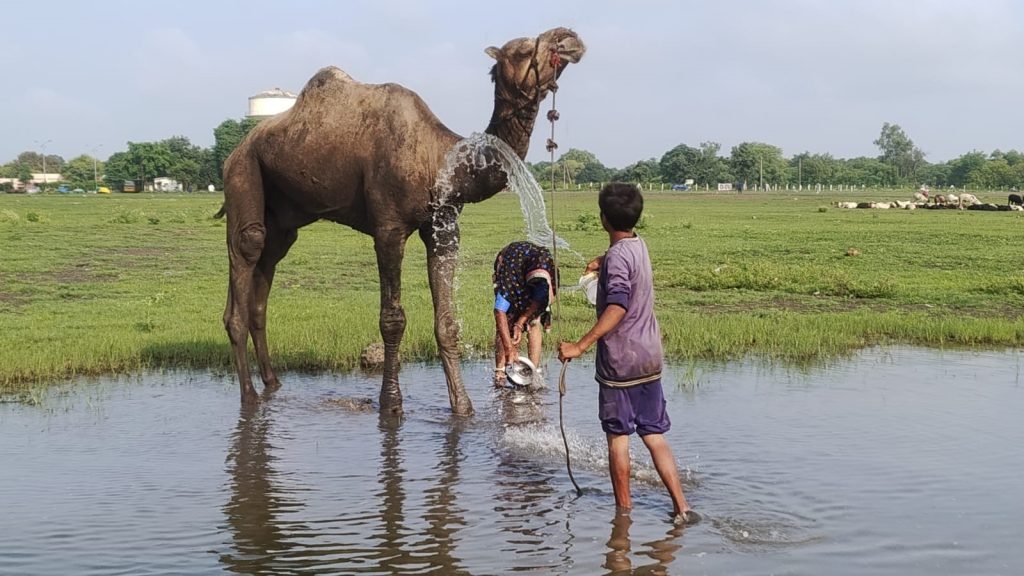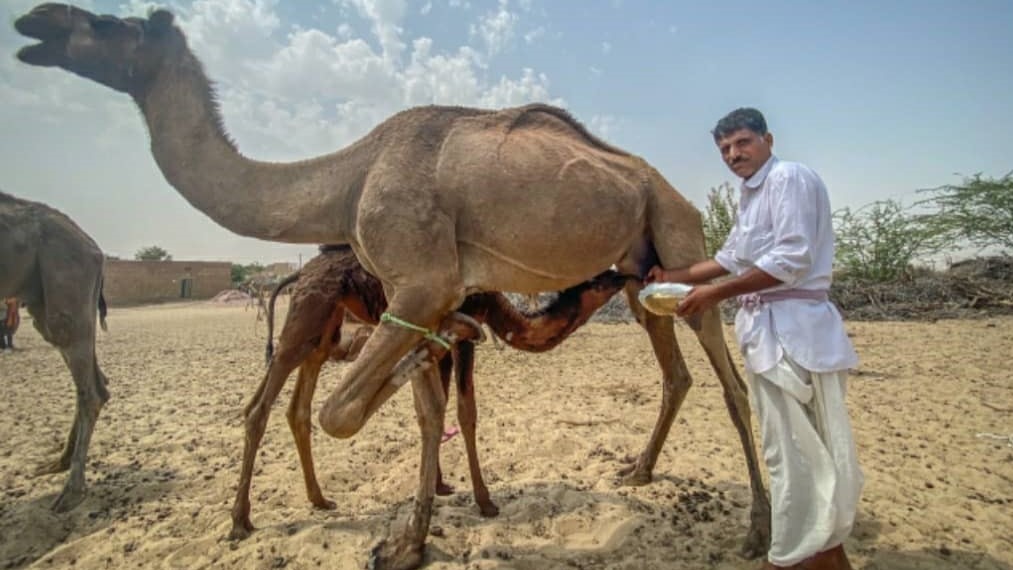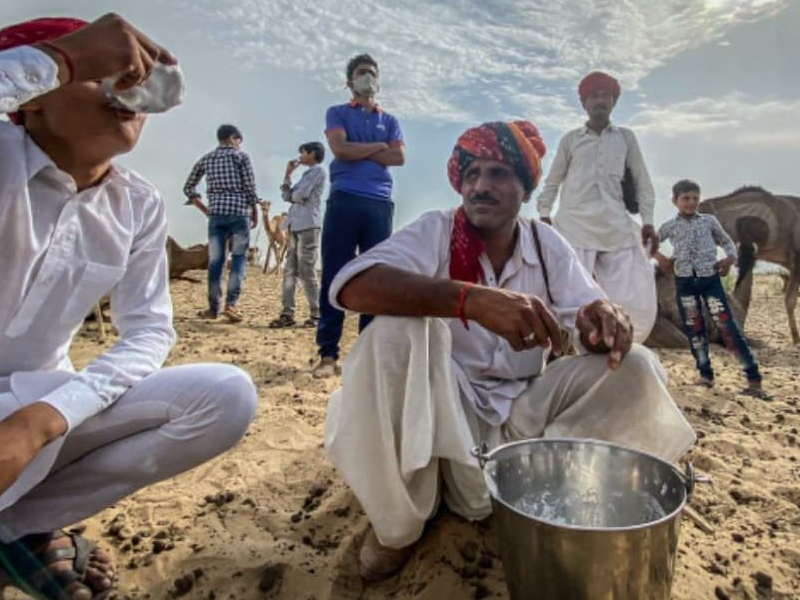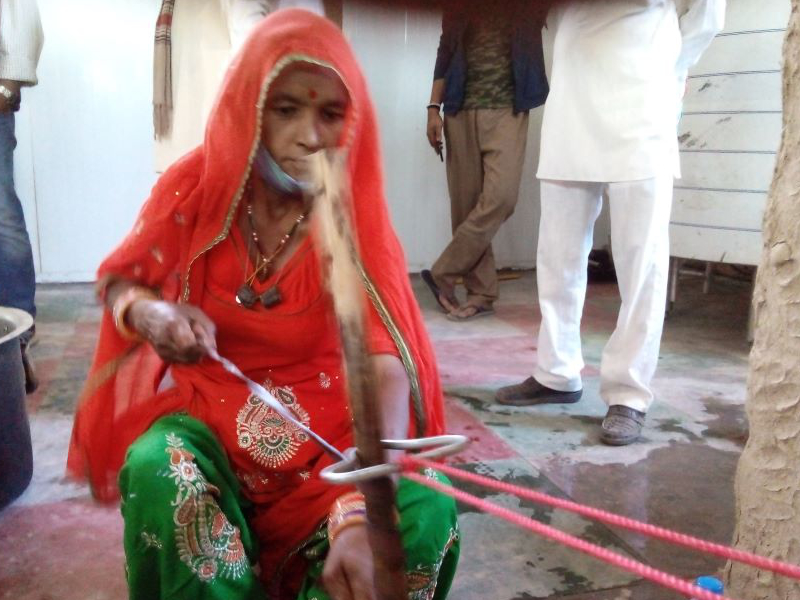Camels are called the ship of the desert and they have been a way of life for the people of the Thar Desert, a part of which is spread over the western Rajasthan. But with the change in times and the impact of so called development and modernisation, the camel-based economy and way of life in this difficult patch of desert has come under a severe strain.
Both camels and camel herders have suffered for the want of resources of living and ways of livelihood and while the camel population has shrunk considerably, life of people dependent on them became difficult by the passing day. In such situation, NGO Urmul Seemant Samiti – a part of the umbrella organisation URMUL – Uttari (North) Rajasthan Milk Union Limited has initiated a slew of diversified interventions in the villages of three districts of Bikaner, Jodhpur and Jaisalmer to preserve the camel-based livelihood and lifestyle as much as possible and also conserve the camels as locally important lifeforms.
Here is a deeper look at the way of life of the camels and camel herders and the interventions that has and can go long way in preserving and conserving this unique lifestyle
Introduction
The western plains of Rajasthan is the famous Thar Desert. It is considered that in some ancient time, this area was under a sea, which has since dried up. Thar is a sandy desert – a very dry expanse of sand with plains of sand, dunes of sand and hills of sand. Sand landscape is interspersed by small thorny bushes and rare plants and trees. There is a dearth of water and weather is extreme with severe hot and cold conditions. This is because the sand warms up and cools down very quickly. Sandstorms are common in summers and this causes the sand dunes to form and change places. The roads get totally covered by the sand. Therefore, life is very difficult in the desert with lack of water at the centre of it. People and animals equally have to struggle for water. But despite these struggles, life flourishes in the desert. Also there is immense potential, an initiative to tap which has been taken by NGO Urmul Seemant Samiti – with special focus on camels and camel herders/pastoralists.
About the Urmul Seemant Samiti
The URMUL became a trust in 1984 and the Urmul Seemant Samiti is a part of this family and has its headquarters in Bajju of Bikaner. The organisation runs a number of programmes on health, education, embroidery, knitting, permanent livelihood, sustainable agriculture, kitchen gardens and others. They specifically worked for the livelihood of camel herders and other animal herders. They involved the community for conservation of pastures and sacred groves (oasis). Agriculture and animal husbandry are the major sources of livelihood in the region. Till some years ago, camels were the main way of transport and commute here, but now camels themselves are facing a crisis.
A discussion was held with several camel herders, shepherds and pastoralists in Bikaner and Jodhpur. The initiatives being undertaken to save camels and the livelihood options related to them were also witnessed. Discussions were also held with activists of Urmul Seemant Samiti and members of village level committees. Basically, the current condition of camels, pastures and the institutional initiatives in the desert related to these were investigated.
The Growing Crisis of Camels
Camel is the state animal of Rajasthan. The 20th animal census figures show that there has been a fall of 34.69% in the population of camels, meaning the number has gone down from 3.26 lakhs to 2.13 lakhs. Anshul Ojha of Desert Resource Centre (the technical policy advisory organisation for Urmul), who works with villagers and camel herders says that diminishing pastures/groves, lack of health facilities and diminishing income generated through camels are leading to an increasing crisis on camels. Therefore the organisation has intervened in the matter and taken initiatives at various levels.

Initiatives of Seemant Sanstha
The Camel Partnership
The Urmul Seemant Samiti is conducting The Camel Partnership programm through which camel herders are linked to social enterprises with the aim of promoting livelihood for them through camel milk. Number of initiatives are taken with the help of veterinarians, organisations working in animal rearing field, marketing experts and camel herders and their associations. This work is being done in three clusters of Bajju (Bikaner), Chimana (Jodhpur) and Pokhran (Jaisalmer).
Common Facility Centre
When there is scarcity of fodder and water in the desert, the pastoralists migrate with their herds of animals. They have traditional pasture routes, but they face various problems during the migration. Mainly, the continuous walking tires out the animals and they also fall ill.
Common facility centres are being developed in Kalu and Kelan villages of Lunkaransar block of Bikaner district to help the animals and pastoralists. These centres, on the traditional pasture routes, will provide health facilities, vaccination, water, fodder and resting facilities for the animals. Veterinarians will also be available. Traditional pastures are being developed on the fallow lands.
Camel Milk Dairies
Recently, on February 14, 2021, a camel milk dairy was set up at Bajju in Bikaner. Here, camel milk is processed to make various products like chocolates, sweetmeat and biscuits. Also there is a lookout for a market for these products. These initiatives will be economically beneficial for the camel herders and their diminishing interest in camel herding will pick up. Also a camel milk dairy has been set up in Pokhran (Jaisalmer). Also camel milk collector centres are being opened in various villages.
Pasture Development
Most of the pastoralists felt that if the forage/fodder could be arranged within or near the village, it would be very helpful. With this objective, the organisation has taken up the development of common property resources for forage in the four villages – Bhopalaram Dhani, Kelan, Kalu and Rajasar Bhatiyan. On a total 98 hectare land in the four villages, forage such as moringa, sevan grass, daman grass, khejdi, ber etc are grown. The programme is supported by the National Rainfed Area Authority (NRAA) and the Food and Agriculture Organisation (FAO) of the United Nations. The organisation also provides indigenous forage seeds to the pastoralists. The availability of forage/fodder in or near the villages will ensure that the pastoralists do not have to migrate or migrate only for a short duration. The Seemant Samiti is doing this work in collaboration with Urmul Setu – another member of Urmul network.
Village Committees and Federation of Camel Herders
Village level committees of camel herders have been set up in the villages of three clusters of Bajju, Chimana and Pokhran and there are also federations of a group of committees. The committees and federations assist the initiatives of the organisations, link the camel herders and pastoralists to the programme, discuss the issues of the camel herders and pastoralists and take due steps to resolve them. Also these federations act as links for market and administration. Some of the federations constituted are – Shri Balinath Oont Paalak Federation, Shri Pabuji Oont Paalak Federation, Chimana, Shri Aainath Oont Paalak Federation, Pokhran and others.
Policy Initiative and Advocacy from Panchayat Level
The organisation is in constant dialogue with the state government and departments dealing with animal husbandry and camel rearing. Government departments are part of the The Camel Partnership programme. Discussions and communication on issues related to the environment as well as livelihood protection of camel herders and pastoralists are a continuous process.
Camels were Beasts of Burden; Grazed on Sewan Grass
Morh Singh of Grandhi village (Bajju, district Bikaner) says that 20 years ago he owned 20 camels as well as 1000 sheep and 300 goats. Now he has just 10 camels and even these he does not personally rear, but they are part of a group herd.

Camels graze in open fields. Morh Singh says the normal forage for camels is khejdi leaves as well as babul, jaal, fong, ber, kair, sidiya, fog, bolti, roheda, borti, khinp, kinkar, sewan grass, dhaman grass, murat grass, bekar, kanti, hareni, lona grass and other such forage. In earlier days, camels were used for all routine works including tilling and irrigating agriculture land, transporting goods, pulling water from deep wells, on camel carts used for commuting and as well as for riding. Walking is difficult in desert lands and therefore camels were used to ride long distances. Some people made the camels dance for earning livelihood. Camel races were also organised.
Further, camel hair was used to weave mats, traditional ropes to tie camel feet and as nose ropes and other products like bags, shawl, carpets and others. Other than using these products personally, the pastoralists also sold them in the local markets. The weaving was done mostly at homes using handlooms.
Camel Herds Are Endangered; Pastures Are Shrinking
Gyanaram Raika of Grandhi village operates a common herd of camels (tola). He takes them grazing and takes general care of them. His herd has 300 camels that belong to him as well as other herders in his and nearby villages. The camels are marked for identification through a process called ‘kheng’. The camel owners identify their own in this way.
Raika says that there is a huge problem of grazing for the camels as the pastures and groves have been encroached upon by some people and being used for agriculture. Also there are restrictions by the forest department. In most of the pastures, the trees have been cut down and in many others farming is done.
Gyanaran says that camels can sustain on very little water, but even that little water is available with difficulty. There is a need for small traditional water bodies (jod paytans like naadi, talai, johad) to deal with water scarcity.
He says that earlier he owned 100 cows and a huge amount of ghee was produced that was stored in big containers. Rather, water was stored in smaller pots. People consumed a lot of ghee and never got tired even after walking long distances.
Camel Carts Can’t Ply Due to Canals
Pokaram of Bhaluri village (2MKDA) says that he owns 13 bigha lands. Earlier he had five camels, 15 cows and 20 goats. He used to drive camel carts right from childhood and all agriculture work was also done using camels. When irrigation canals were not available he had migrated to Ganganagar. But since irrigation canals were developed, he returned to farming. But since then the use of camels has reduced and camel carts have stopped playing.
There is little rainfall in the Thar desert. People as well as animals face the challenge of food/fodder and water. Therefore, pastoralists migrate every year and follow traditional pasture routes.
Sayar Devi of Mithlia village says that a lot of her daily time is spent taking care of the animals. She wakes up very early, milks the cows, gives fodder and water to the animals, cleans the shelters, cooks for the family and feeds them, cuts and brings back grass for animals, gives them water etc.
Sayar Devi owns a camel, 20 cows and 10 goats. Her husband is ailing with paralysis and therefore she has to do all household chores as well as outside work including grazing of the camel. Volunteer of Urmul Seemant and a resident of Charanwala village in Bikaner, Kalu Raika says that every year, the camel herders and pastoralists migrate to the irrigated areas of Rajasthan as well as to Punjab, Firozepur. They normally migrate around October-November and return in June-July next year. Their migration starts when forage and water scarcity starts. They return only when grass starts growing again with rainfall. This cyclic migration has continued since generations.


Kalu Raika says that camel herders and pastoralists travel in a group and encamp in farmlands or open fields. They go to such areas where leftover fodder of paddy, wheat, gram and other crops is available for the animals. Farmers normally welcome the animals as they produce manure for them. Earlier these farmers even grave the pastoralists some foodgrain in exchange of the manure, but this system is dying off now and thus the herders face a lot of difficulties.
Kalu Raika says that during the tenure of the last government, a grant of Rs 10,000 was given for protection and conservation of camel calves under the Ushtra Vikas Yojana (camel conservation scheme). The present government has discontinued the scheme, but Raika feels it should be immediately restarted. Also insurance of camels should be undertaken and these animals should be provided with free medicines.
Kulfi and Biscuits of Camel Milk
Volunteer of Urmul Seemant Samiti Suraj Singh said that they are studying biodiversity in the project area like documenting types of grasses, varieties of trees, herbs and medicinal plants, traditional crops, desert food habits and the traditional knowledge related to camel herders and pastoralists. The main objective is to create awareness on the issues.
Apart from this, biscuits made of bajra and camel milk are being sold in Bikaner markets and directly by Urmul Seemant and kulfi (ice-candy like product) made of camel milk is also sold in Bikaner. The organisation is also promoting products made of camel hair and sheep wool under its handicrafts programme. Around 4000 women are linked to the handicraft and embroidery programme and come up with products like mats, bags, socks and others. These products are now known as ‘Desert craft’ or ‘Thar Maru kala’ or ‘Thar embroidery’. An entire chain of bringing the handicrafts products to markets is in place and involves several organisations. This has improved the livelihood and economic condition of the women.
Anshul Ojha of Desert Resource Centre said that The Camel Partnership programme has been launched to resolve the issues of camel herders and work is being done at various levels.
Dairy based on camel milk has been started in Bajju where products of camel milk are made and livelihood of camel herders is ensured. Common facility centres have been developed in the two villages Kalu and Kelan where arrangements for the stay of migrating pastoralists and their herds is made. Pastures are being developed so that forage and water is available and a facility to treat and vaccinate the animals has also been made.
Overall, it could be said that the Urmul Seemant Samiti has taken an important initiative to save and conserve camels, pastures, desert biodiversity as well as livelihood of the camel herders. People have started taking interest in pastoralists, camel milk dairies are leading to ensuring their livelihood and products like biscuits and kulfi are adding to their income. The common facility centres are a big relief to the pastoralists as they also ensure health of the camels as well as conservation of the traditional breeds of camels. To save the camel breeds, ensuring conducive environment, adequate forage and water and health facilities is important.
It is difficult to evaluate the work only on the basis of economic gains or losses. The initiative is still in initial stages but when considered in the long term, the programme is crucial and important as regards preservation of biodiversity, environment and situational mechanism of the desert. It will ensure avenues of permanent livelihood, improve the living conditions of the pastoralists and conserve environment and biodiversity.
The programme is also important as it is a labour-based and animal-based source of livelihood rather than being machines based. This ensures conservation of energy, fuels like petrol and diesel, prevent pollution and carbon emission and overall protect the environment. The pastures of deserts will come to life again, tree plantation will lead to increase in greenery. Naturally, animal-based livelihood is most suitable for a desert region. In the local conditions, the traditional pastoralist activity is a source of permanent livelihood that is sustainable and safe as regards the environment.
